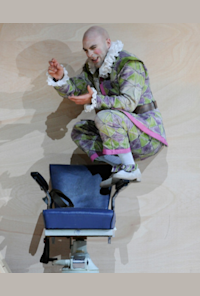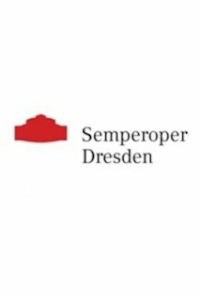Three epochs on the theater
Reflections on the new production of »Le nozze di Figaro«
Today, Mozart's »Le nozze di Figaro« is one of the most frequently performed, well-known and popular operas in the repertoire. But does it really still have something to tell us 230 years after its creation and, depending on how you count it, at least five to six revolutions later (1789, 1848, 1918, 1945, 1968, 1989)? How can this model opera from the »Viennese Classic« era be brought to us in the 21st century?
For the Dresden »Figaro« conception, we were inspired by a philologically impermissibly free interpretation with reference to the work of Beaumarchais, which goes further than just the immediate model. For us, the three plays of what is now known as the »Figaro« trilogy by Beaumarchais can be read pointedly as references to three different genres, each of which is embedded in historically distinguishable socio-cultural contexts. And these different points of view lead from the Rococo of the 18th century through the European revolutions to our present-day bourgeoisie.
"Useless Prudence, or The Barber of Seville" from 1775 - although originally conceived as a text for an opera - is still most closely associated with the Hanswurstiads that Beaumarchais wrote around 1763, i.e. a popular theater of fairs that, like the oldest forms of commedia dell'arte in Italy was originally offered as a kind of stand-up baiting game with always the same scenic templates and figures in front of the wooden stalls at the fair. Full of crude situational comedy, slapstick elements and undisguised sexual insinuations, it summed up common human feelings. And that's exactly why the viewers should have recognized and laughed at themselves behind the templates of the characters, their standardized costumes and the repetitive plot.
Beaumarchais' »The Great Day or The Marriage of Figaro«, composed and premiered in Paris in 1784 on the brink of revolution, is the wittiest piece of the entire trilogy with its cheeky satire and mockery of the world of the nobility. As its centerpiece, it is also truly its heart, because here, beyond fun and emotion, a social concern is articulated. It is a comedy with fun in the revolution, an intrigue that goes far beyond situation comedy, with wit and using already quasi-psychological justifications.
»L'Autre Tartuffe ou la Mère coupable« (»A second Tartuffe or The guilt of the mother«, actually more: »the sinful, adulterous mother«), composed in 1790, premiered in Paris in 1792, the post-revolutionary piece that is perhaps rightly almost forgotten today The end of the Beaumarchais trilogy is best understood by us as an anticipation of the bourgeois tragedy in the form of a comedy that is still preserved, as we may encounter today in well-done boulevard theater. The play is set in 1790, the French Revolution has happened, and the characters we know have actually moved to Paris in the meantime and are practicing bourgeois life. As it then gradually emerges, the mother's guilt lies in the love she has lived out since the events of "The Great Day" for Cherubino, who, having fallen himself, left her a son: Léon, who now officially lives in the Count's Parisian palace as his son. But the Count now also has a secret daughter from another woman, Florestine, whom he has taken into his house as a ward. On the one hand, this results in a constellation of figures reminiscent of »The Great Day«, in which the Count and Countess forgive each other as equal culprits and can still do without the option of marriage/divorce, which has meanwhile been officially introduced. On the other hand, as already indicated in the title with the explicit reference to Molière, a new constellation has been introduced in that Figaro finds a highly talented opponent in Monsieur Bégearss, who is similar to Tartuffe and who is after everyone's money. who now officially lives in the count's palace in Paris as his son. But the Count now also has a secret daughter from another woman, Florestine, whom he has taken into his house as a ward. On the one hand, this results in a constellation of figures reminiscent of »The Great Day«, in which the Count and Countess forgive each other as equal culprits and can still do without the option of marriage/divorce, which has meanwhile been officially introduced. On the other hand, as already indicated in the title with the explicit reference to Molière, a new constellation has been introduced in that Figaro finds a highly talented opponent in Monsieur Bégearss, who is similar to Tartuffe and who is after everyone's money. who now officially lives in the count's palace in Paris as his son. But the Count now also has a secret daughter from another woman, Florestine, whom he has taken into his house as a ward. On the one hand, this results in a constellation of figures reminiscent of »The Great Day«, in which the Count and Countess forgive each other as equal culprits and can still do without the option of marriage/divorce, which has meanwhile been officially introduced. On the other hand, as already indicated in the title with the explicit reference to Molière, a new constellation has been introduced in that Figaro finds a highly talented opponent in Monsieur Bégearss, who is similar to Tartuffe and who is after everyone's money. But the Count now also has a secret daughter from another woman, Florestine, whom he has taken into his house as a ward. On the one hand, this results in a constellation of figures reminiscent of »The Great Day«, in which the Count and Countess forgive each other as equal culprits and can still do without the option of marriage/divorce, which has meanwhile been officially introduced. On the other hand, as already indicated in the title with the explicit reference to Molière, a new constellation has been introduced in that Figaro finds a highly talented opponent in Monsieur Bégearss, who is similar to Tartuffe and who is after everyone's money. But the Count now also has a secret daughter from another woman, Florestine, whom he has taken into his house as a ward. On the one hand, this results in a constellation of figures reminiscent of »The Great Day«, in which the Count and Countess forgive each other as equal culprits and can still do without the now officially introduced possibility of marriage/divorce. On the other hand, as already indicated in the title with the explicit reference to Molière, a new constellation has been introduced in that Figaro finds a highly talented opponent in Monsieur Bégearss, who is similar to Tartuffe and who is after everyone's money. On the one hand, this results in a constellation of figures reminiscent of »The Great Day«, in which the Count and Countess forgive each other as equal culprits and can still do without the option of marriage/divorce, which has meanwhile been officially introduced. On the other hand, as already indicated in the title with the explicit reference to Molière, a new constellation has been introduced in that Figaro finds a highly talented opponent in Monsieur Bégearss, who is similar to Tartuffe and who is after everyone's money. On the one hand, this results in a constellation of figures reminiscent of »The Great Day«, in which the Count and Countess forgive each other as equal culprits and can still do without the option of marriage/divorce, which has meanwhile been officially introduced. On the other hand, as already indicated in the title with the explicit reference to Molière, a new constellation has been introduced in that Figaro finds a highly talented opponent in Monsieur Bégearss, who is similar to Tartuffe and who is after everyone's money.
Projected onto Mozart's "Le nozze di Figaro", the reference to Beaumarchais' drama trilogy can be used by now recognizably realizing the first act as "outdated" theater with figures from the Commedia dell'arte: Susanna and Figaro, Count and Cherubino, Marcellina and Bartolo, dressed in commedia dell'arte costumes and mirroring each other, perform on a plank stage on stage, which allows the theater's box of tricks to be experienced in a very literal sense. We then make Mozart's second and third »Figaro« acts look like a rococo theater that illustrates the fun of intrigues and deception, wit and hide-and-seek as »revolutionary« provocation and rebellion against the corporate order.
This can then correspond to the melancholy and sadness of bourgeois security as well as to the good order of the faithful marriage apparently restored in Mozart's finale. The constant emphasis on the theatrical situation with visible references to historical theater forms in the stage design, the costumes and the directing of the characters hopefully makes the very rudimentary human feelings that are still at stake in today's life again understandable at the core of this game within the game: desire , fun, jealousy, lust, fear and yes – love! (...)








